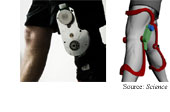|
NEWS
|
Power suits
Clothing made from fibers covered with nanoscale
bristles could generate electricity from the wearer's
movements and even the wearer's heartbeat. Fibers coated
with vertical nanowires produce electricity when the nanowires
brush against each other, inducing the piezoelectric effect.
Such nanowire fabrics could be used to power personal
electronic devices and sensors. (Microfibre–Nanowire
Hybrid Structure for Energy Scavenging, Nature,
February 14, 2008)
Power walking
 A knee brace performs regenerative breaking for
people, converting energy from each stride into electricity.
The device captures energy normally lost as you slow down
the forward swing of your leg, and requires little more
effort than normal walking. A pair of the devices produces
as much as 5 watts of electricity; the energy could be
used to power prosthetic limbs and portable devices. (Biomechanical
Energy Harvesting: Generating Electricity During Walking
with Minimal User Effort, Science, February
8, 2008)
A knee brace performs regenerative breaking for
people, converting energy from each stride into electricity.
The device captures energy normally lost as you slow down
the forward swing of your leg, and requires little more
effort than normal walking. A pair of the devices produces
as much as 5 watts of electricity; the energy could be
used to power prosthetic limbs and portable devices. (Biomechanical
Energy Harvesting: Generating Electricity During Walking
with Minimal User Effort, Science, February
8, 2008)
Low-power chips
A new way of making computer chips reduces the
amount of power they consume, promising to extend the
battery life of devices like cell phones and sensors and
enable devices like medical implants that can be powered
by ambient energy. A prototype chip operates on 0.3 volt
rather than the usual 1 volt. (A
65nm Sub-Vt Microcontroller with Integrated
SRAM and Switched-Capacitor DC-DC Converter, International
Solid-State Circuits Conference, February 3-7, 2008, San
Francisco, CA)
Biofuels' down side
A pair of studies shows that converting food cropland
and uncultivated land to biofuel cropland causes a net
increase in greenhouse gases. The carbon emissions from
clearing these lands to convert them outweigh the emissions
reductions from replacing fossil fuels with the biofuels
grown on the cleared lands. (Use
of U.S. Croplands for Biofuels Increases Greenhouse Gases
Through Emissions from Land Use Change, Land
Clearing and the Biofuel Carbon Debt, Science,
published online February 7, 2008)
Double-stranded DNA conducts
Single DNA molecules in their native double-stranded
configuration are good electrical conductors. Even a single
mismatch between the two strands, however, decreases the
molecule's conductance 300 fold. The knowledge promises
to help researchers develop sensors and medical diagnostic
devices, and could improve efforts to develop DNA-based
nanoelectronics. (Conductivity
of a Single DNA Duplex Bridging a Carbon Nanotube Gap,
Nature Nanotechnology, published online February
10, 2008)
Updatable holographic display
A 4- by 4-inch holographic display made from photorefractive
polymers produces three-dimensional images within a few
minutes. The images can be viewed for several hours without
needing to be refreshed and can be completely erased.
Holographic three-dimensional images, which can be viewed
without special eyewear, are useful for medical, military
and industrial imaging. (An
Updatable Holographic Three-dimensional Display, Nature,
February 7, 2008) |
FEATURES
|
View
from the High Ground: ICL's John Pendry
Physics as machine tool, negative refractive
index, metamaterials, shattered wine glasses, higher capacity
DVDs, scientific backwaters, risk perception and practice,
practice, practice.
|
How
It Works: Quantum computing: qubits
Photons, electrons and atoms, oh my! These particles are
the raw materials for qubits, the basic building blocks
of quantum computers. |
|
 |
News RSS feed 
Blog RSS feed 
Bookshelf RSS feed

New: TRN's
Internet Services
TRN's Jobs Center
|
| |
|
| |
|
| |
"Physics
is to the rest of science what machine tools are
to engineering. A corollary is that science places
power in our hands which can be used for good or
ill. Technology has been abused in this way throughout
the ages from gunpowder to atomic bombs."
- John Pendry, Imperial College London |
|
| |
|
| |
Thanks
to Kevin from
GoldBamboo.com
for technical support |
|

